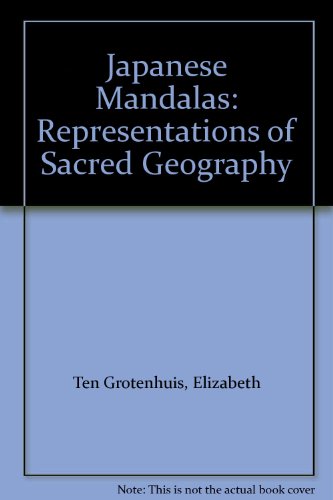Items related to Japanese Mandalas: Representations of Sacred Geography

The first broad study of Japanese mandalas to appear in a Western language, this volume interprets mandalas as sanctified realms where identification between the human and the sacred occurs. The author investigates eighth- to seventeenth-century paintings from three traditions: Esoteric Buddhism, Pure Land Buddhism, and the kami-worshipping (Shinto) tradition. It is generally recognized that many of these mandalas are connected with texts and images from India and the Himalayas. A pioneering theme of this study is that, in addition to the South Asian connections, certain paradigmatic Japanese mandalas reflect pre-Buddhist Chinese concepts, including geographical concepts. In convincing and lucid prose, ten Grotenhuis chronicles an intermingling of visual, doctrinal, ritual, and literary elements in these mandalas that has come to be seen as characteristic of the Japanese religious tradition as a whole.
This beautifully illustrated work begins in the first millennium B.C.E. in China with an introduction to the Book of Documents and ends in present-day Japan at the sacred site of Kumano. Ten Grotenhuis focuses on the Diamond and Womb World mandalas of Esoteric Buddhist tradition, on the Taima mandala and other related mandalas from the Pure Land Buddhist tradition, and on mandalas associated with the kami-worshipping sites of Kasuga and Kumano. She identifies specific sacred places in Japan with sacred places in India and with Buddhist cosmic diagrams. Through these identifications, the realm of the buddhas is identified with the realms of the kami and of human beings, and Japanese geographical areas are identified with Buddhist sacred geography. Explaining why certain fundamental Japanese mandalas look the way they do and how certain visual forms came to embody the sacred, ten Grotenhuis presents works that show a complex mixture of Indian Buddhist elements, pre-Buddhist Chinese elements, Chinese Buddhist elements, and indigenous Japanese elements.
"synopsis" may belong to another edition of this title.
From most studies on this subject we get the view that mandalas originated in the Indian context and spread to China and Japan. What sets this study apart is the exploration of a Chinese, pre-Buddhist origin for the East Asian concept of mandala. Ten Grotenhuis (Harvard and Boston Univ.) examines the mandalas of Pure Land Buddhism, Esoteric Buddhism, and Shintoism from the eighth to 17th centuries, focusing mainly on paintings. Her pioneering assertion that Japanese mandalas follow Chinese texts on sacred geography will change the way most scholars look at the use of this ritual and sacred art...The book is readable and beautifully presented to the nonspecialist. For the specialist in the fields of religion and art, Buddhism, Asian religions, and comparative religions, ten Grotenhuis presents many avenues for further research. General readers and all academic levels. - L.L. Lam-Easton, California State University, Northridge -- Choice, October 1999, vol. 37, no. 2
"About this title" may belong to another edition of this title.
- PublisherUniv of Hawaii Pr
- Publication date1999
- ISBN 10 0824820002
- ISBN 13 9780824820008
- BindingHardcover
- Number of pages227
- Rating
(No Available Copies)
Search Books: Create a WantIf you know the book but cannot find it on AbeBooks, we can automatically search for it on your behalf as new inventory is added. If it is added to AbeBooks by one of our member booksellers, we will notify you!
Create a Want
